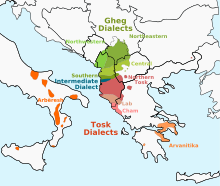Albanian-language
| Albanian | |
|---|---|
| Shqip, Gjuha shqipe | |
| Pronunciation | [ʃcip] |
| Native to | Albania, Kosovo, Macedonia, Montenegro, Serbia, Greece and Albanian diaspora |
|
Native speakers
|
5.4 million (ca. 2011) |
|
Indo-European
|
|
| Dialects | |
|
Latin (Albanian alphabet) Albanian Braille |
|
| Official status | |
|
Official language in
|
|
|
Recognised minority
language in |
|
| Regulated by | Officially by the Social Sciences and Albanological Section of the Academy of Sciences of Albania |
| Language codes | |
| ISO 639-1 | sq |
| ISO 639-2 |
(B) (T)
|
| ISO 639-3 |
Individual codes: aae – Arbëresh aat – Arvanitika aln – Gheg als – Tosk |
| Glottolog | alba1267 |
| Linguasphere | 55-AAA-aaa to 55-AAA-ahe (25 varieties) |
 |
|
Albanian (shqip [ʃcip] or gjuha shqipe [ˈɟuha ˈʃcipɛ], meaning Albanian language) is an independent branch of the Indo-European family of languages, spoken by over five million people, primarily in Albania, Kosovo, the Republic of Macedonia, and Greece, but also in other areas of Southeastern Europe in which there is an Albanian population, including Montenegro and the Preševo Valley of Serbia. Centuries-old communities speaking Albanian-based dialects can be found scattered in Greece, Southern Italy,Sicily, and Ukraine. Due to the large Albanian diaspora, the total number of speakers is much higher than the native speakers in Southeast Europe.
The first written mention of the Albanian language was on 14 July 1284 in Dubrovnik (modern-day Croatia), when a certain Matthew, witness of a crime, stated "I heard a voice shouting on the mountainside in the Albanian tongue" (Latin: Audivi unam vocem, clamantem in monte in lingua albanesca). The first audio recording of Albanian was made by Norbert Jokl on 4 April 1914 in Vienna. During the five-century period of the Ottoman presence in Albania, the language was not officially recognized until 1909, when the Congress of Dibra decided that Albanian schools would finally be allowed.
...
Wikipedia
